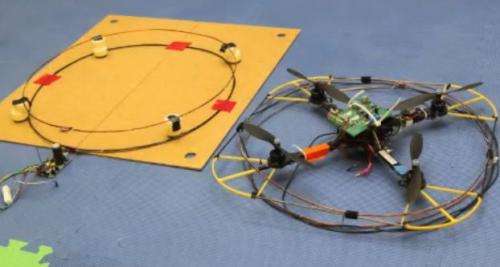May 31, 2012 report
Nimbus Lab sends up quadrotors for wireless charging (w/ Video)

(Phys.org) -- Researchers at the University of Nebraska-Lincoln’s Nimbus Lab are exploring wireless power transmission as a way to power devices. They have designed and built a custom power-transfer and receiving system optimized for use on unmanned aerial vehicles (UAVs) to do the job. Brent Griffin and Carrick Detweiler are the creators of these special "quadrotors" which are designed to wirelessly charge electronics making use of “strongly coupled resonances.” The Nimbus team have made a video showing these wireless quadrotor chargers in action. The video caption says the UAV sends nearly 5 watts at 25 cm.
According to a report in IEEE Spectrum, how much power gets from quadrotor to the receiver and how efficient is the transmission are linked to how well the quadrotor can keep close to the optimum transmission distance, about 20 centimeters away from the receiver coil. “When everything works perfectly, the quadrotor can wirelessly transfer about 5.5 watts of power with an efficiency of 35 percent, which is easily enough to power a light,” says the report.
According to the lab team, “We are investigating systems and control algorithms to optimize the power transfer from the UAV to the remote sensor node. In addition, we are investigating energy usage algorithms to optimize the use of the power in networks of sensors that are able to be recharged wirelessly from UAVs.”
They say that applications include powering sensors in remote locations without access to grid or solar energy, such as underwater sensors that surface intermittently to send data and recharge, sensors placed under bridges for structural monitoring, and sensors only activated when the UAV is present.
Moving their research forward, the Nimbus team plans to teach the quadrotor to autonomously keep a stable hover at an optimum distance to transfer power to a receiver. They also hope to be able to boost the amount of power the quadrotor can transfer.
Nimbus stands for Nebraska Intelligent Mobile Unmanned Systems. The lab was partly funded through a grant from the Air Force Office of Scientific Research and UNL support.
“Resonant Wireless Power Transfer to Ground Sensors from a UAV, “by Brent Griffin and Carrick Detweiler, was presented recently at the 2012 IEEE International Conference on Robotics and Automation in St. Paul, Minnesota.
More information: nimbus.unl.edu/projects/
© 2012 Phys.Org



















